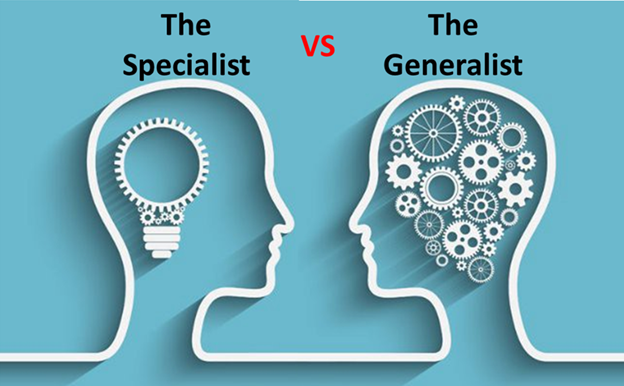
BECOME A DEEP GENERALIST
In 2018, the world held its collective breath as two Australian doctors spearheaded the rescue mission of 12 school boys and their soccer coach who were trapped underground in a flooded Thai cave. Both Aussie rescuers are proficient medicos and adept divers and it was this atypical combination of skills that made the duo perfect for the daring operation.
Research has long shown that we can all gain from spending time outside of our specialism. With reference to the cave rescuers, they have formal training and acclaim in two unrelated domains – medicine and cave diving – and this qualifies each of them to be called a polymath*. The word polymath is a 17th century Greek term which describes a person with “many learnings”.
Throughout history, many notable individuals have pursued multiple interests. Albert Einstein was an accomplished violinist as well as a physicist. Leonardo da Vinci was an artist, inventor, scientist, architect, and engineer. Thomas Edison was a prolific inventor, entrepreneur, poet, and writer. The world’s most intriguing Renaissance men were all polymaths or deep generalists.
The label “polymath” is often applied to Elon Musk as he excels in multiple fields and has used his cross-discipline expertise as a physicist, engineer, economist, and entrepreneur to tackle some of society’s most pressing challenges. He has built three multibillion-dollar companies in three disparate industries – aerospace (SpaceX), automotive (Tesla Inc.), and energy (SolarCity). But that’s not all!
In 2016, Musk co-founded a mind-computer interface company (Neuralink Corp.) which is developing brain implants that can communicate with computers. In the same year, he started a tunnel construction business (The Boring Company) to create fast-to-dig transportation tunnels. Musk also came up with the idea for an ultra-high speed, futuristic transportation system (The Hyperloop).
Throughout his life, Musk has displayed a relentless pursuit of knowledge and an unrivalled talent for applying his learnings across a range of industries. He has been called the quintessential modern polymath. His world-changing intellect has become a symbol of the power of being an expert generalist with the ability to generate breakthrough insights and innovations.
Yet conventional wisdom still frowns on being a “jack-of-all-trades, master of none”. From the time we enter school, we are constantly encouraged to specialise by choosing a clear path and then sticking with it. And once we enter the workforce, the pressure to specialise is ever present. Being a generalist has long been seen as the road to mediocrity.
Paradoxically, research shows that people with too many interests are more likely to succeed. This certainly holds true for the founders of five of the largest companies in the world – Bill Gates (Microsoft), Steve Jobs (Apple), Warren Buffett (Berkshire Hathaway), Larry Page (Google), and Jeff Bezos (Amazon). All are polymaths who follow the 5-hour rule (minimum learning time each work week).
Polymaths see the world differently and make connections that are otherwise ignored. A case in point is Francis Crick who discovered the structure of DNA. He began his scientific career in physics and later made the transition in to biology. Crick claimed that this diverse background gave him the confidence to solve problems that other biologists couldn’t.
Many of the world’s other great inventions also arose as a result of multifaceted thinking. Nikola Tesla was a pioneer in many fields but is most remembered for inventing the radio. In doing so, he drew on his skills as an electrical engineer, theoretical physicist, mathematician, and futurist. Elon Musk’s electric car company is named after Nikola Tesla.
Even though the world remains obsessed with specialisation, the evidence for deep generalists is growing. In his book, Range – Why Generalists Triumph in a Specialized World, David Epstein examines the world’s most successful individuals across a range of human endeavours. He discovers that in most fields – especially those that are complex and unpredictable – generalists, not specialists, are the ones who excel.
Epstein reports that when researchers study great innovators, they typically find “systems thinkers” with an “ability to connect disparate pieces of information from many different sources” and who “read more than other technologists”. Simply put, generalists invariably do better than specialists in putting two and two together across domains.
Charles Darwin is considered by Epstein to be the ultimate example of someone whose breadth of training enabled him to remain open-minded and innovative. Prior to sailing to the Galápagos Islands, Darwin studied natural history, medicine, theology, and geology. This cross-training enabled him to build the intellectual firepower that he would later need to overturn centuries of dogma.
The Digital Age has made it easier for us to become polymaths. Today, information is everywhere, and more often than not, it’s free. Wannabe polymaths can become proficient in multiple fields by allocating at least one hour per day for deliberate learning and reading. The one habit that all high-performers share is reading lots of books across various disciplines.
My desire to continually learn new things and improve my knowledge is one of the reasons I maintain a blog. Without exception, the research I undertake in writing each post helps broaden my horizons and aids my self-development. Moreover, learning keeps my brain active and stimulated and this (hopefully!) helps boost my cognitive health.
For readers of this blog, my posts are deliberately designed to make you think, as they tangle and weave through disparate but connected topics. By joining the dots, you will gain a helicopter view of where individual disciplines intersect and overlap. And by cross-pollinating ideas from a range of fields, you will be able to make new connections and see more creative solutions to contemporary problems.
Notwithstanding this, Western educational systems still lean towards deep specialisation, which is why UK researchers argue that we need a radical shake-up of school curriculums to ensure arts and sciences are no longer taught separately. Educational experts believe that teaching children to think like Leonardo da Vinci would better prepare them for tackling complex issues.
When it comes to tertiary education, it has long been my contention that universities around the world will increasingly be challenged to turn out graduates with broader interdisciplinary degrees. The answers to the big global issues we face – like climate change – cannot be found within traditional single disciplines such as economics or science or politics on their own.
For this reason, I believe that one subject that should be embedded in most university degrees is the study of biomimicry. Biomimicry is the art and science of emulating nature’s best biological ideas and applying these solutions to product design, architecture, engineering, technology, business, and medicine. Biomimicry is relevant in every sector of society.
Velcro is probably the best-known example of innovation inspired by nature. The product’s inventor, George de Mestral, stumbled upon the idea by examining how burrs stuck to the hair of his dog. By mimicking the strong attachment forces of the burrs’ small hooks, he was able to develop Velcro straps and fasteners.
Similarly, Airbus observed how sea birds sense gust loads in the air with their beaks and adjust the shape of their wing feathers to suppress lift. As a result, Airbus installed probes on its A350 aircraft which detect gusts ahead of the wing and deploy moveable surfaces for more efficient flight. Airbus engineers continue to study the natural world for modern aircraft design solutions.
Mother Nature is by far the smartest “person” I know. She is the ultimate polymath and genius and we humans can learn much from her. She has been giving lessons in design and solving problems for billions of years, but only in recent times have we started “enrolling” in her classes. Using nature as a mentor, professionals from a range of fields are now studying biomimicry, but more of us need to look to nature for creative solutions.
■ ■ ■
It’s never too late to pick up a new area to add to your repertoire of skills. If you can combine unique skills in creative ways, you may well be one of tomorrow’s great problem-solvers and innovators. In an era of rapid-fire technological and social change, we all need to embrace our inner polymath because we are more than the sum of our parts.
May polymaths inherit the Earth.
*Some academics argue that only individuals proficient in three disparate areas can call themselves polymaths.
Regards
Paul J. Thomas
Chief Executive Officer
Ductus Consulting


POLYMATH – Sir Jack Brabham, three times world champion. A man of many skills – mechanic, engineer, car designer, team Owner/manager, F1 Driver. The first man to build a rear engine Indianapolis car. BIOMIMICRY – A fascinating topic! The bullet train design was biomimicry inspired plus other biomimicry influences including the beak of a king fisher, the wings of an owl and the belly of a penguin. Great work, Paul, thank you very much.
Hello Paul,
This is one of the most well researched and informative blogs that I have read. This blog really opens up the interesting and important topic of addressing/applying a marginalised career development approach.
It also contains many contemporary examples of polymath personality successes…providing much food for thought.
Polymaths can now better understand their own potential contribution and value to society, when applied appropriately.
When to generalise and to specialise has always been a challenging career planning issue.
It was also helpful to get a reminder about continuous improvement, the 5-hour rule!
Many thanks,
Des